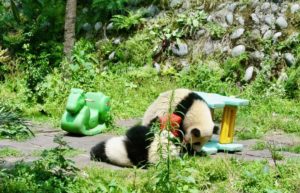Giant pandas give birth to twins about 50% of the time. Interestingly, this season at Bifengxia, the majority of births have been twins. Though a twin birth is equally likely, mothers often choose to raise only one cub. She may attempt to care for both at birth, but as newborn pandas are altricial (blind, hairless, and generally helpless), she will end up selecting one cub to whom she’ll devote all her energy. This has been seen both in captivity and in the wild: one cub is accepted while the other is rejected. Luckily, Bifengxia has a strategy for allowing the mother to raise both cubs, albeit not simultaneously.
To maximize—and equalize—the mother’s attention with each cub, the base practices “twin-swapping.” Though done more frequently when first born, these 2-month-old cubs are on a set schedule of swapping every ten days. Keepers are adept at separating the mother from the cub using panda bread or bamboo (their favorite treats), and then swapping one twin for the other. While away from Mom, the cubs are cared for in the nursery.
For the Maternal Care study, I spend my mornings watching mother-infant interactions. Recording both the mother and cub’s behaviors, we are able to study her attentiveness, quality of care, and most common interactions. The results of the study should be very interesting: Will mothers interact with each cub differently? Will she spend more time in contact (cradling, nursing, licking, etc.) with one twin versus the other? What are the factors that affect her choice (size, strength, sex)? Do mothers develop strategies for raising more than one cub at a time? Will experienced mothers be more or less attentive, and which of her behaviors carry from one birthing season to the next?
Even as new cubs are born in the Breeding Center, I still take the time to visit two of last year’s cubs at the Panda Kindergarten. It’s always fun stopping by their enclosure and seeing them up in the trees or playing with their enrichment “toys.” They seem to enjoy getting themselves in trouble!
_______________________________________________________
 Katherine Brantley is enjoying the “cute” side of giant panda research given that she observes the interactions between mothers and cubs. If you have any questions about this study, I’m sure she would appreciate hearing from you.
Katherine Brantley is enjoying the “cute” side of giant panda research given that she observes the interactions between mothers and cubs. If you have any questions about this study, I’m sure she would appreciate hearing from you.




You have the best job!
Can’t wait to hear more about “twin-swapping”! Survival of the fittest is important but I hate to think of even 1 panda not surviving! Good luck with your research! Looking forward to more twins and more tales of twins!
Sincerely, JoAnn Mann
Lucky you! Can’t wait to hear about your studies – who are the new mothers this year|
Best,
Karen
Hi Karen,
Unfortunately, we cannot share private behind-the-scenes information from the CCRCGP. I wish that I could update you on this years new crop, but we have to honor their requests.
Cheers-